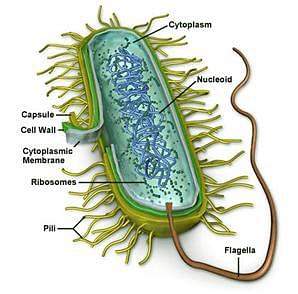Methanogens belong to -
- Eubacteria
- Archaebacteria
- Dinoflagellates
- Slime moulds
The Correct Option is B
Approach Solution - 1
The correct answer is Option 2: Archaebacteria.
Explanation:
Methanogens are a type of archaebacteria (also known as archaea) that produce methane as a by-product of their metabolism. They are typically found in anaerobic environments, such as the intestines of ruminants, swamps, and marshes. Methanogens play a crucial role in the carbon cycle by producing methane (CH4), a potent greenhouse gas.
Eubacteria (Option 1) refers to the "true bacteria" that are different from archaea.
Dinoflagellates (Option 3) are a group of protists, many of which are marine plankton, and are not involved in methane production.
Slime moulds (Option 4) are a group of eukaryotic organisms that exhibit both amoeba-like and fungal-like characteristics, and they do not produce methane.
Thus, methanogens belong to Archaebacteria, which is Option 2.
Approach Solution -2
Answer: Methanogens belong to Archaebacteria.
Detailed Explanation:
Methanogens are microorganisms that produce methane as a by-product of their metabolism. They belong to the domain Archaebacteria, which is distinct from the true bacteria (Eubacteria). Methanogens are known for their ability to carry out anaerobic respiration, in which they use carbon dioxide (CO₂) and hydrogen (H₂) to produce methane (CH₄).
These microorganisms are typically found in extreme environments like swamps, marshes, the intestines of ruminants (e.g., cows, sheep), and other anaerobic conditions where oxygen is absent. Methanogens play an essential role in the carbon cycle and are important in the global methane cycle, a potent greenhouse gas.
Key Features of Methanogens:
Anaerobic Respiration: Methanogens generate methane by reducing carbon dioxide in the absence of oxygen. This process is part of their metabolic pathway.
Extreme Environments: Methanogens are found in environments without oxygen, such as the deep ocean, marshes, and the digestive tracts of animals.
Cell Wall and Membranes: Unlike typical bacteria, archaebacteria, including methanogens, have ether-linked lipids in their cell membranes, which help them survive extreme conditions. They lack peptidoglycan in their cell walls, distinguishing them from Eubacteria.
Obligate Anaerobes: Methanogens cannot survive in the presence of oxygen, as oxygen is toxic to them. This makes them obligate anaerobes.
Overall, methanogens are integral in producing methane gas, contributing to the methane cycle, and are vital components of anaerobic ecosystems.
Top Questions on Kingdom Monera
- In which of the following animals, does the digestive tract have additional chambers like crop and gizzard?
- NEET (UG) - 2023
- Biology
- Kingdom Monera
- Component of cytoskeleton present in a cell are
- WBJEE JENPAS UG - 2022
- Biology
- Kingdom Monera
- In which era reptiles were dominated?
- WBJEE JENPAS UG - 2022
- Biology
- Kingdom Monera
- Which one of the following malarial parasite has the longest incubation period?
- WBJEE JENPAS UG - 2022
- Biology
- Kingdom Monera
- Identify the diagram of heterocyst.
- JIPMER - 2019
- Biology
- Kingdom Monera
Questions Asked in NEET exam
- Two identical point masses P and Q, suspended from two separate massless springs of spring constants \(k_1\) and \(k_2\), respectively, oscillate vertically. If their maximum velocities are the same, the ratio of the amplitude of P to the amplitude of Q is :
- NEET (UG) - 2025
- Waves and Oscillations
A sphere of radius R is cut from a larger solid sphere of radius 2R as shown in the figure. The ratio of the moment of inertia of the smaller sphere to that of the rest part of the sphere about the Y-axis is :

- NEET (UG) - 2025
- Moment Of Inertia
- A microscope has an objective of focal length \(f_o = 2\) cm and an eyepiece of focal length \(f_e = 4\) cm. The tube length of the microscope is \(L = 40\) cm. If the distance of distinct vision of eye is \(D = 25\) cm, the magnification in the microscope is:
- NEET (UG) - 2025
- Optical Instruments
AB is a part of an electrical circuit (see figure). The potential difference \(V_A - V_B\), at the instant when current \(i = 2\) A and is increasing at a rate of 1 amp/second is:

- NEET (UG) - 2025
- Electromagnetic Induction and Inductance
- Twins are born to a family that lives next door to you. The twins are a boy and a girl. Which of the following must be true?
- NEET (UG) - 2025
- Genetics
Concepts Used:
Kingdom Monera
Characteristics of Monera Kingdom
The organisms in this kingdom have the following characteristics: -
- Monerans are single-celled creatures.
- The cell wall is made up of peptidoglycan and is stiff.
- Binary fission is asexual reproduction.
- They have 70S ribosomes in them.
- The locomotory organ is the flagella.
- Organelles such as mitochondria, lys
- osomes, plastids, Golgi bodies, endoplasmic reticulum, centrosome, and others are not present.
- These are decomposers and mineralizers for the environment
